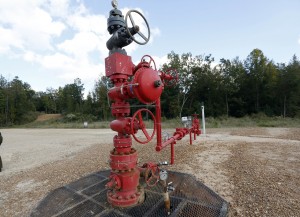From an Article by Kiley Koscinski, WESA News 90.5 FM, Pittsburgh, March 10, 2022
Plum officials, residents and environmental advocates are organizing to prevent a second fracking waste injection well in the borough just outside of Pittsburgh. In a press conference Thursday, environmental group Protect Penn-Trafford said it would join an appeal against the borough’s zoning board.
“Many municipal boards feel like this industry is so big that they can’t win when in fact they have more power than they realize,” said Gillian Graber, executive director of Protect PT. “The Plum residents and Protect PT stand with Plum Borough in doing what’s right for the community.”
Delmont-based Penneco Environmental Solutions, which operates the first injection well, applied for a permit in September to convert a second oil and gas well on the same property into an injection well. Ben Wallace, chief operating officer for Penneco, said the second well is needed to increase capacity and operate more efficiently.
Residents are already concerned about how their community has been affected by another injection well that began operating last year. Residents have complained about changes in their well water and truck traffic.
Injection wells store brine created during oil production. The environmental groups argue the fluids, which are too toxic to be processed at municipal wastewater plants, threaten private well water and could induce earthquakes.
Plum Borough Council has been actively trying to prevent the second injection well from moving forward. To do that, council had to file an appeal last month against its own zoning board, which approved the Penneco application in January.
“The Borough is appealing the decision of the Zoning Hearing Board because Penneco failed to show that its proposed expansion will not be detrimental to the health, safety and welfare of the people of the neighborhood, and the community of Plum Borough as required by the Zoning Ordinance,” said Dave Vento, Plum Borough Council Member.
Katie Sheehan, a resident of Plum Borough who lives near the Penneco property, said Thursday she has noticed changes in the color and taste of her well water after the well began operating last spring.
“I wouldn’t dare drink our well water,” she said. “We’ll always be concerned about the probability that our water may be contaminated.”
Sheehan said she has filed complaints with the Department of Environmental Protection, the Environmental Protection Agency and the Allegheny County Health Department about water changes and a chemical odor in the air after the well began operating.
Wallace said complaints about water changes have not been linked to Penneco after investigations by the DEP and EPA.
Sheehan said high truck traffic has also become a noise and pollution nuisance in the formerly quiet neighborhood. Trucks transport the briny water from shale wells to the injection well.
“Truck traffic is essentially 24/7,” she said. “I am concerned about the truck emissions, noise level and concerns for speeding and most of all the concern for what they are carrying.”
Protect PT said if the injection wells were to leak, they could increase the risk of earthquakes, pollute groundwater and the Allegheny River and risk contaminating water in the Greater Pittsburgh region. Wallace argued that the site is highly regulated and the well isn’t deep enough in the earth to cause seismic activity.
“It may be new in Plum Borough, but there are thousands upon thousands of these,” sites across the country, Wallace said. “People don’t want a landfill near them, but it doesn’t mean that landfills are not well understood or that landfills are dangerous.”
Penneco has asked members of Plum Borough council who are opposed to the injection wells to tour the property and learn about how the wells operate, but Wallace said the board has not responded to those requests.
“Not one of them has ever taken us up on that invitation,” Wallace said. “We operate safely and we operate in accordance with the law.”
There is still a long way to go before a second injection well could be installed. The first injection well on the site underwent a years-long permitting process. A public hearing about the second injection well application is forthcoming with the Environmental Protection Agency.

